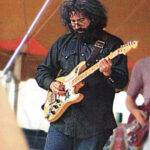Jimi Hendrix. The name itself is synonymous with the electric guitar, instantly conjuring images of him wielding a Fender Stratocaster with unparalleled virtuosity. While the Stratocaster became his most recognized weapon of choice, Hendrix, like any true guitar aficionado, possessed a deep appreciation for a vast spectrum of instruments. From the familiar curves of Strats to the quirky charm of Supros, the classic lines of Gibsons to the rare allure of Danelectros, Jimi Hendrix explored a wide sonic palette through his guitars. While his groundbreaking music continues to be studied and celebrated, delving into the world of Jimi Hendrix’s guitars offers another fascinating dimension to understanding his artistry.
Let’s embark on a chronological journey through some of the most significant guitars in Jimi Hendrix’s career. This exploration isn’t exhaustive, but it will highlight the instruments that played pivotal roles in shaping his legendary sound and are inextricably linked to iconic moments in rock and roll history.
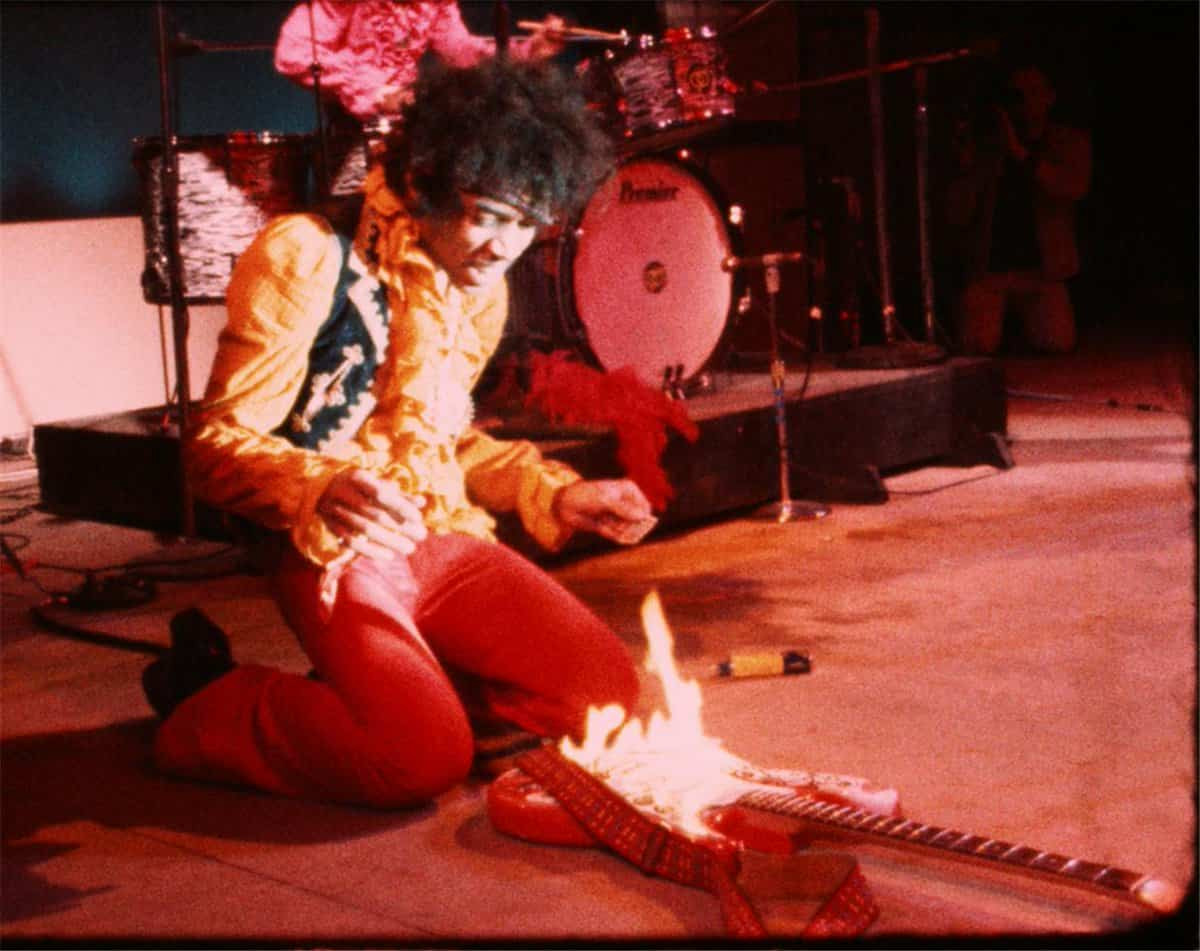 Jimi Hendrix burning his Stratocaster guitar at the Monterey Pop Festival, 1967
Jimi Hendrix burning his Stratocaster guitar at the Monterey Pop Festival, 1967
Stratocasters: The Soulmate Guitars of Jimi Hendrix
Although Jimi Hendrix experimented with various guitars, the Fender Stratocaster remains his most enduring association. Once his career ascended to international heights, the Stratocaster became his primary instrument, almost exclusively appearing in his performances and recordings. Let’s examine some of the essential and truly iconic Stratocasters that defined Jimi Hendrix’s sound.
1960 Fender Stratocaster – “Carol”: The Genesis Strat
This 1960s Fender Stratocaster model holds the distinction of being likely the very first Stratocaster Jimi Hendrix ever owned, marking the beginning of a lifelong love affair with this iconic guitar. Hendrix’s girlfriend at the time, Carol, gifted him this guitar while they were in New York City. This acquisition was particularly significant as it preceded his pivotal move to the United Kingdom in 1966, the journey that would ignite his global career. In its original state, the guitar was entirely stock. Hendrix, being left-handed, restrung it to accommodate his playing style, a common practice for him with right-handed guitars.
The subsequent history of this guitar is shrouded in some mystery. It is known that this was not the white Stratocaster he carried to the UK. It appears this “Carol” Stratocaster saw only brief use before Hendrix’s departure from the United States. Rumors persist that Jimi may have smashed this guitar during a performance, but considering his financial struggles at the time, such an act seems unlikely.
1964 Fender Stratocaster – “Linda”: The UK Launchpad
In 1966, a chance encounter in New York City after a show brought Jimi Hendrix into contact with Linda Keith, then the partner of Rolling Stones guitarist Keith Richards. Recognizing Hendrix’s exceptional talent, Linda Keith generously offered her support, lending him a white 1964 Fender Stratocaster from Keith Richards’ own collection. This guitar became known as “Linda”.
“Linda” was the sole guitar Jimi Hendrix took with him when he embarked for the United Kingdom in 1966. Throughout that year, it became his primary instrument for live performances overseas, including notable television appearances in December. Music historians also believe that “Linda” was likely used in the recording of the timeless classic “Hey Joe.”
Like most of Jimi Hendrix’s Stratocasters, “Linda” remained in its stock configuration, without any modifications. Unfortunately, the current whereabouts of this historically significant guitar are unknown. It was reportedly stolen sometime in 1967 and has never been recovered, making it a lost treasure of rock history.
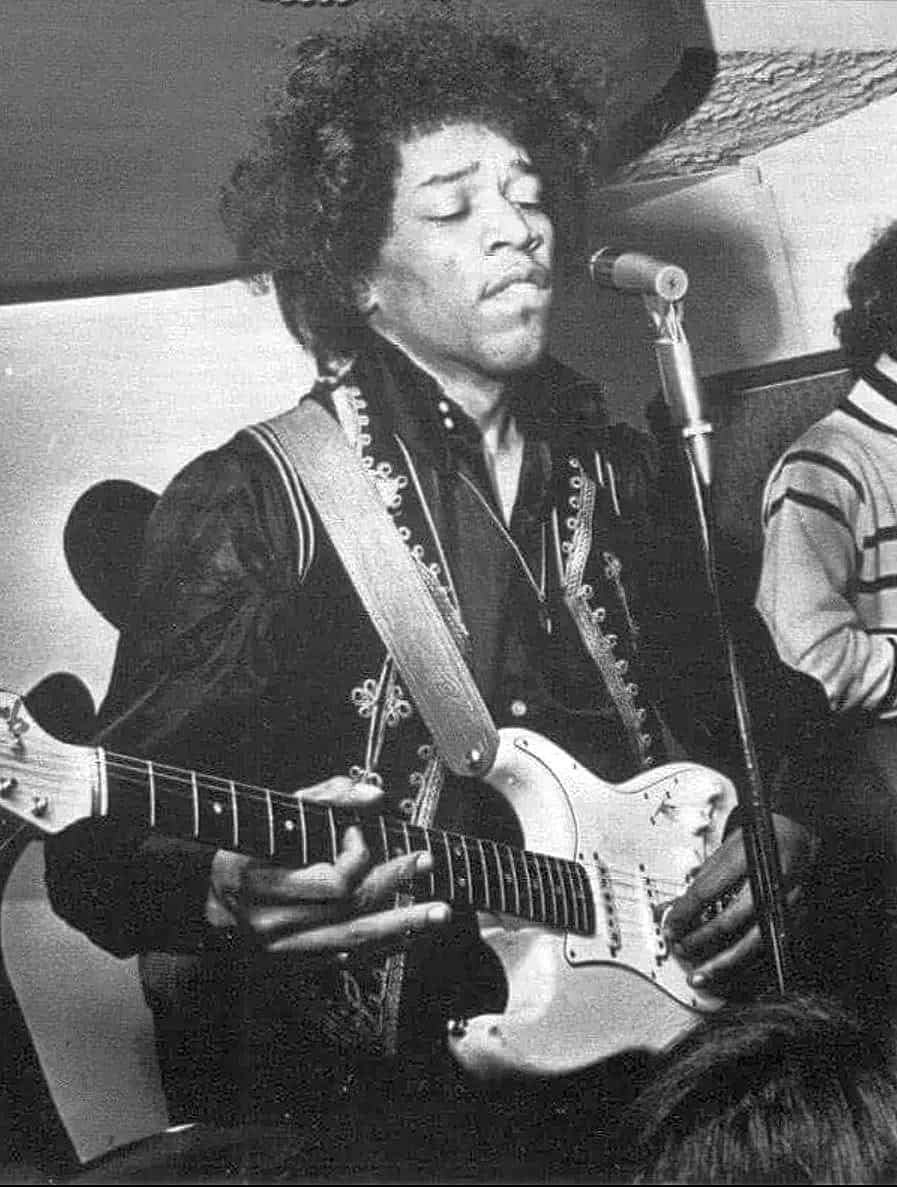 Jimi Hendrix masterfully playing his white Fender Stratocaster, affectionately nicknamed Linda, during a performance
Jimi Hendrix masterfully playing his white Fender Stratocaster, affectionately nicknamed Linda, during a performance
1960s Fender Stratocaster – “Zappa”: The Scorched Enigma
Jimi Hendrix’s heavily scorched 1960s Stratocaster, later owned by Frank Zappa and subsequently his son Dweezil Zappa, stands as one of the most visually striking and iconic guitars associated with Jimi Hendrix.
Frank Zappa claimed to have acquired this guitar from Jimi Hendrix’s roadie and assistant, Howard Parker, in 1968. According to Zappa’s account, Hendrix ceremonially burned the guitar at the Miami Pop Festival. However, this story has been challenged and doesn’t fully align with documented events.
Multiple eyewitness accounts contradict the Miami Pop Festival burning story, confirming that Jimi Hendrix did not burn any guitars during his performance there. Furthermore, the “Zappa” Stratocaster exhibits significant burn damage, raising questions about its true origin story.
It is documented that Jimi Hendrix burned three guitars in his career, and the “Zappa” Stratocaster might actually be the guitar he ignited at his performance at the Astoria Theatre in Lancashire, England. Scratches and wear patterns on the back of the guitar body appear to match photographic evidence of the Astoria Stratocaster.
Mysteries surrounding the “Zappa” Stratocaster persist. Howard Parker was not working for Hendrix at the time of the Astoria gig, so how did he come into possession of the guitar? And how did the guitar travel from London to the United States? Why would Jimi Hendrix transport a burnt and damaged guitar? These unanswered questions contribute to the enigmatic allure of the “Zappa” Stratocaster, making it one of the most puzzling guitars in the Jimi Hendrix legacy.
 A vintage 1977 issue of Guitar Player magazine showcasing Frank Zappa with Jimi Hendrix's scorched black Stratocaster guitar
A vintage 1977 issue of Guitar Player magazine showcasing Frank Zappa with Jimi Hendrix's scorched black Stratocaster guitar
1963/64 Fender Stratocaster – Monterey Pop: The Fiery Sacrifice
The 1963 or 1964 Fender Stratocaster that Jimi Hendrix dramatically set ablaze at the Monterey Pop Festival is perhaps his single most famous guitar. He acquired this guitar sometime in early 1967, and its first documented appearance was on the television show “Top of the Pops” in March of that year.
Originally, this Stratocaster was finished in red and featured a rosewood fretboard, distinguishing it from Hendrix’s usual preference for maple necks with maple fingerboards. Sometime in 1967, he had the guitar repainted with a now-iconic psychedelic design, further enhancing its visual impact.
Despite its vibrant and peaceful aesthetic, this Stratocaster was ritually sacrificed at the Monterey Pop Festival after Hendrix’s electrifying performance of “Wild Thing.” Following the fiery spectacle, Hendrix smashed the guitar into pieces. A fragment of this legendary instrument is now preserved at the Museum of Pop Culture in Seattle, serving as a tangible piece of rock history.
Even though Jimi Hendrix used this particular guitar for a relatively short period, its iconic status is so profound that Fender has released multiple Monterey Stratocaster models in its honor, ensuring its legacy endures.
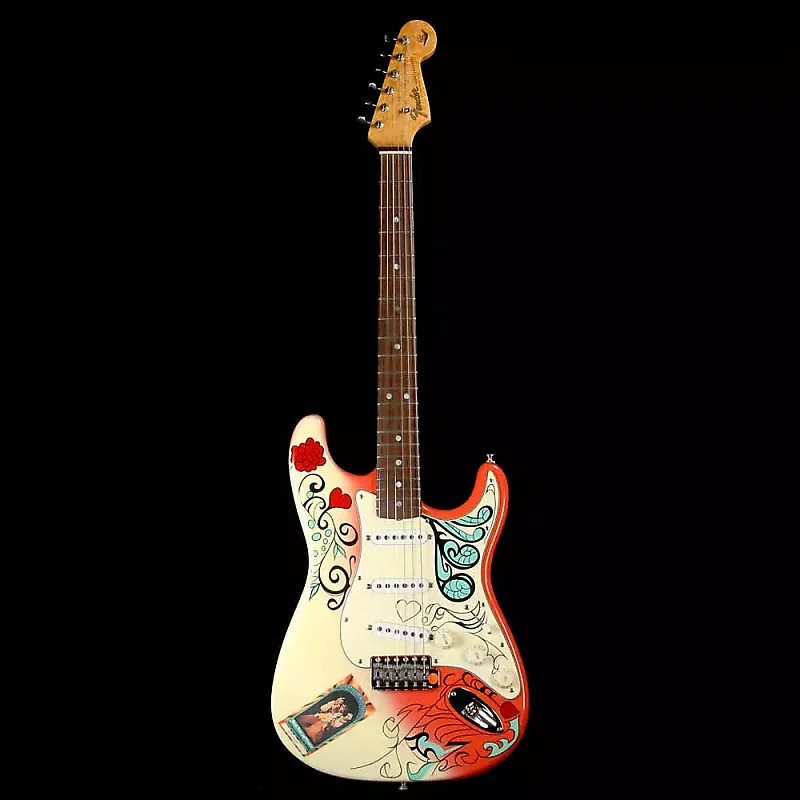 A Fender Custom Shop Jimi Hendrix Monterey Stratocaster guitar, a tribute to the iconic original
A Fender Custom Shop Jimi Hendrix Monterey Stratocaster guitar, a tribute to the iconic original
1965/66 Fender Stratocaster – Monterey Black: The Survivor
This black Fender Stratocaster appears to have been a favorite of Jimi Hendrix, as he played it extensively throughout 1967. It was his main guitar during his entire Monterey Pop Festival performance. Crucially, unlike its red counterpart, this black Stratocaster survived the Monterey Pop show and continued to be played at subsequent performances at the Fillmore West and the Whiskey a Go-Go later that same year.
However, while not definitively confirmed, it’s believed that Jimi Hendrix burned this black Stratocaster at the Ambassador Theater in Washington, D.C. This event is considered the last documented instance of him burning a guitar on stage. Following the burning, the guitar was smashed, and Hendrix signed the pieces and distributed them to the venue’s staff as mementos.
In 2012, a guitar purported to be Jimi Hendrix’s black Monterey Stratocaster was offered for sale. However, its authenticity has been widely questioned. A detailed video analysis from CGS thoroughly examines the discrepancies and issues surrounding its claimed provenance, casting significant doubt on its legitimacy.
1960s Fender Stratocaster – Modified: The Pickup Experiment
Jimi Hendrix was only seen playing this modified 1960s Stratocaster a few times in 1967, but it is notable for being the only known modified guitar Hendrix ever used on stage.
The modification centered around the pickup switch system. Instead of the standard five-way switch found on Stratocasters, this guitar featured three independent toggle switches. This unique configuration allowed Jimi Hendrix to independently turn each individual pickup on or off, creating a vast array of different pickup combinations and tonal possibilities, expanding beyond the typical Stratocaster sounds.
However, Hendrix may not have been entirely enamored with this modification, as he was never seen using this configuration again. The current whereabouts of this experimental Stratocaster remain unknown. It’s speculated that the modified pickguard might have been replaced with a standard Stratocaster pickguard wired to traditional specifications, and Hendrix simply reverted to playing it in a more conventional manner, but this remains conjecture.
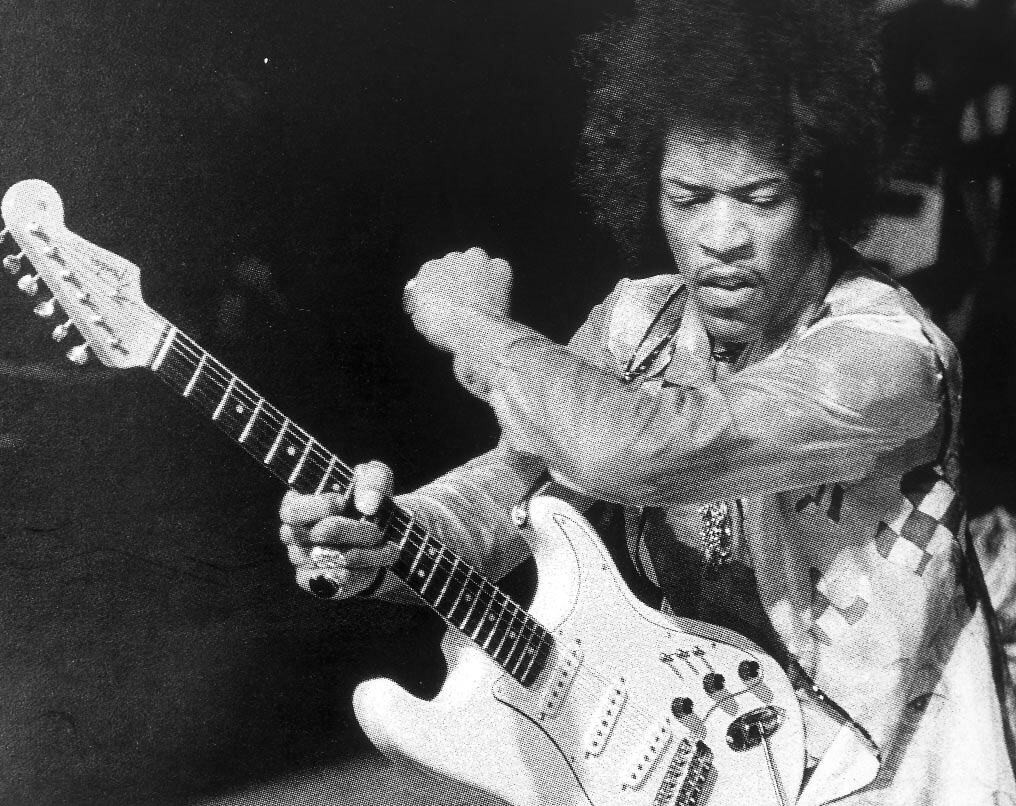 Jimi Hendrix performing live in 1967, playing the uniquely modified Stratocaster guitar
Jimi Hendrix performing live in 1967, playing the uniquely modified Stratocaster guitar
1967 Fender Stratocaster – White: The Electric Ladyland Studio Companion
Jimi Hendrix utilized this 1967 white Fender Stratocaster extensively throughout most of 1968, and it seems to have been another of his favored instruments during this period. This white Stratocaster was used in performances at the Miami Pop Festival and the Fillmore East in 1968, as well as numerous other shows.
This particular white Stratocaster is also one of the most well-documented guitars in Jimi Hendrix’s arsenal, primarily because he used it extensively during the recording sessions for his landmark album Electric Ladyland. Eddie Kramer, the engineer for the album, specifically recalled Jimi Hendrix using a white Stratocaster for the recording of the epic track “Voodoo Chile”—highly likely to be this very guitar.
1968 Fender Stratocaster – Woodstock: The Anthem of a Generation
Jimi Hendrix’s performance at the Woodstock Festival in 1969 is arguably his most legendary and iconic moment. This 1968 Fender Stratocaster, played during that historic set, is perhaps the most iconic of all the guitars associated with Jimi Hendrix.
Hendrix acquired this 1968 Stratocaster sometime during that year. It remained in its stock configuration, and he used it regularly in the lead-up to the Woodstock Festival in August 1969.
In 1970, Jimi Hendrix gifted this Woodstock Stratocaster to Mitch Mitchell, the drummer for The Jimi Hendrix Experience. Mitchell kept the guitar until 1991, when he sold it to an Italian television host and music critic. It was later sold again to Paul Allen, the co-founder of Microsoft. Allen established the Museum of Pop Culture (MoPOP) in Seattle, and the Woodstock Stratocaster is now housed there as a treasured artifact of music history, accessible for public viewing.
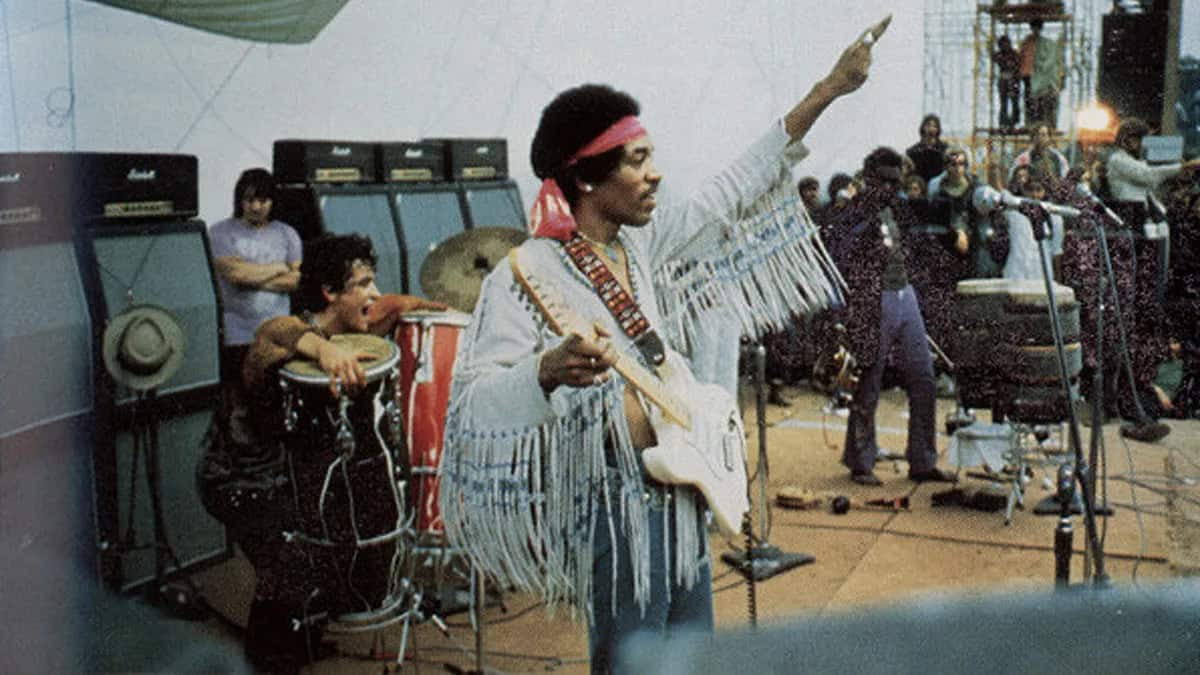 Jimi Hendrix performing at Woodstock, guitar in hand, a defining moment in music history
Jimi Hendrix performing at Woodstock, guitar in hand, a defining moment in music history
1960s Fender Stratocaster – Newport: The Telecaster Neck Hybrid
This Stratocaster stands out as unique among all of Jimi Hendrix’s Stratocasters for one distinct reason—it was fitted with a Telecaster neck. He only used this guitar in two known performances, one of which was at the Newport Folk Festival.
Neal Moser, a luthier based in Hollywood, claims to have repaired this guitar for Jimi Hendrix and installed the Telecaster neck. According to Moser, the original Stratocaster neck was damaged, and when Hendrix needed a replacement quickly, no Stratocaster necks were readily available. Moser had a Telecaster neck on hand, installed it just before the Newport Folk Festival performance, and the “Newport Strat” was born out of necessity.
Outliers and Oddities: Beyond the Stratocaster
While the Stratocaster became Jimi Hendrix’s signature instrument, any guitar he played that wasn’t a Stratocaster can be considered an outlier in his main gear choices. Let’s explore some of the guitars of Jimi Hendrix that deviated from his beloved Stratocaster norm, showcasing his broader guitar interests.
1961 Epiphone Wilshire: Nashville Beginnings
In 1962, Jimi Hendrix relocated to Nashville, Tennessee, and together with his friend Billy Cox, formed a band called The King Casuals. During this formative period, Jimi Hendrix’s primary guitar was a 1961 Epiphone Wilshire. Despite his relative obscurity at this stage of his career, the Wilshire has since become associated with his early days.
This particular Epiphone Wilshire likely underwent modifications, either by Jimi Hendrix himself or a previous owner. The 17th fret inlay was noticeably larger than the standard inlay for this model, suggesting it might have been a sticker applied to enhance its visual appeal. The guitar also featured a tremolo system, which was not a factory option for Wilshires in 1961, indicating an aftermarket addition.
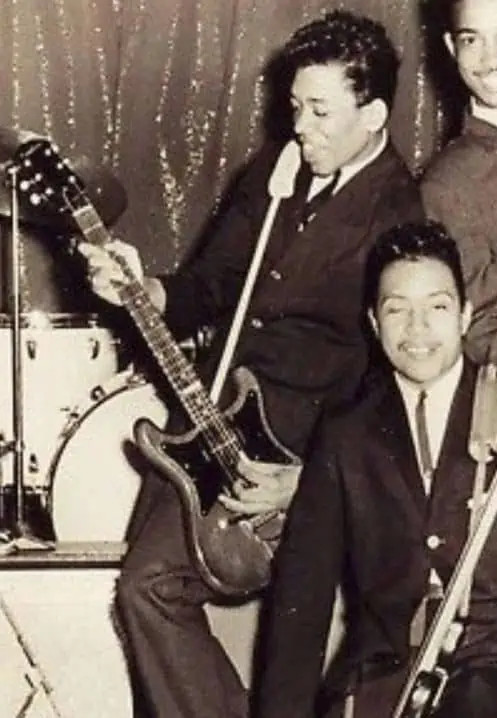 A young Jimi Hendrix playing his Epiphone Wilshire guitar in his early career
A young Jimi Hendrix playing his Epiphone Wilshire guitar in his early career
1967 Hand-Painted Gibson Flying V: Art in Motion
Jimi Hendrix used this 1967 hand-painted Gibson Flying V only briefly, but it remains an incredibly iconic guitar due to its distinctive and vibrant custom paint job. Hendrix acquired this Flying V in the summer of 1967, and it became one of his main stage guitars from then until early 1968. Beyond its unique decorations, the guitar is a standard production 1967 Gibson Flying V.
Rumors have circulated suggesting that Jimi Hendrix used this Flying V on the Electric Ladyland album, specifically on the track “All Along the Watchtower.” However, these rumors remain unconfirmed. Hendrix definitely used the hand-painted Flying V extensively as a stage guitar throughout 1967 and into early 1968, making it a visually striking and memorable part of his performances.
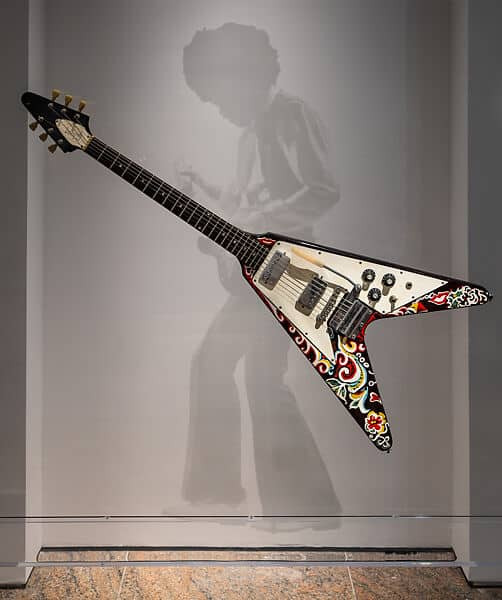 Jimi Hendrix's hand-painted Gibson Flying V on display at the Metropolitan Museum of Art
Jimi Hendrix's hand-painted Gibson Flying V on display at the Metropolitan Museum of Art
Mosrite Joe Maphis 12/6 Doubleneck: Spanish Castle Magic
This Mosrite Joe Maphis 12/6 doubleneck guitar holds a special place in Jimi Hendrix’s discography as it was used to record the iconic track “Spanish Castle Magic” from the Bold as Love album.
Conflicting accounts exist regarding how Jimi Hendrix came to own this unique instrument. Some sources claim he purchased it from a music store in New York City. However, Dana Moseley, daughter of Mosrite founder Semie Moseley, recalls Jimi Hendrix personally visiting the Mosrite factory to pick up the doubleneck guitar.
Regardless of its acquisition story, this Mosrite doubleneck, while not among his most visually iconic or widely recognized guitars, played a crucial role in the creation of one of Jimi Hendrix’s most beloved and sonically adventurous songs.
1965 Fender Sunburst Jazzmaster: The Steven Seagal Connection
This 1965 Fender Sunburst Jazzmaster was not used extensively by Jimi Hendrix himself, although photographic evidence confirms its presence at the Miami Pop Festival. One of the rare sightings of an offset guitar in Jimi Hendrix’s hands, this Jazzmaster has an unusual later history:
It was eventually purchased by Steven Seagal. Yes, that Steven Seagal.
For those unfamiliar with Steven Seagal’s often-overlooked career as a blues guitarist and guitar collector, a detailed video by former Reverb writer Casey Hopkins provides an insightful look. Hopkins’ investigation revealed that Seagal sold off a significant portion of his guitar collection before relocating to Russia. The current whereabouts of this Jimi Hendrix-associated Jazzmaster remain unknown.
1956 Gibson Les Paul Custom – Fillmore West, Miami Pop: Gibson’s Golden Era
While primarily known as a Fender player, Jimi Hendrix did occasionally venture into Gibson territory. This 1956 Gibson Les Paul Custom was acquired by Hendrix in early 1968.
Jimi Hendrix regularly played this Les Paul Custom during performances of “Red House” in the spring of 1968. He also famously used it at the Fillmore East in 1968 and at the Miami Pop Festival a week later.
Beyond these notable performances, Hendrix didn’t use this Les Paul Custom extensively. However, its appearances at two of his most celebrated performances firmly establish it as one of the significant Gibson guitars within the broader context of Jimi Hendrix’s instrument choices.
1967 Gibson SG Custom: The Clapton Tribute
Jimi Hendrix obtained this white 1967 Gibson SG Custom in 1968, and it saw considerable use throughout the remaining years of his career. He frequently employed this SG Custom to play “Sunshine of Your Love” as a direct nod to Eric Clapton’s signature use of an SG with Cream, acknowledging a fellow guitar icon. Most famously, Hendrix played this SG Custom during his memorable appearance on The Dick Cavett Show in 1969.
Speculation suggests that Jimi Hendrix may have favored this SG Custom due to its inherent left-hand-friendly design. SG guitars are nearly symmetrical in body shape, meaning there are no significant ergonomic barriers to playing them upside down and left-handed, unlike many other guitar designs.
Jimi Hendrix’s 1967 Gibson SG Custom is currently on display at the Hard Rock Cafe in Atlantic City, New Jersey, allowing fans to see this piece of music history up close.
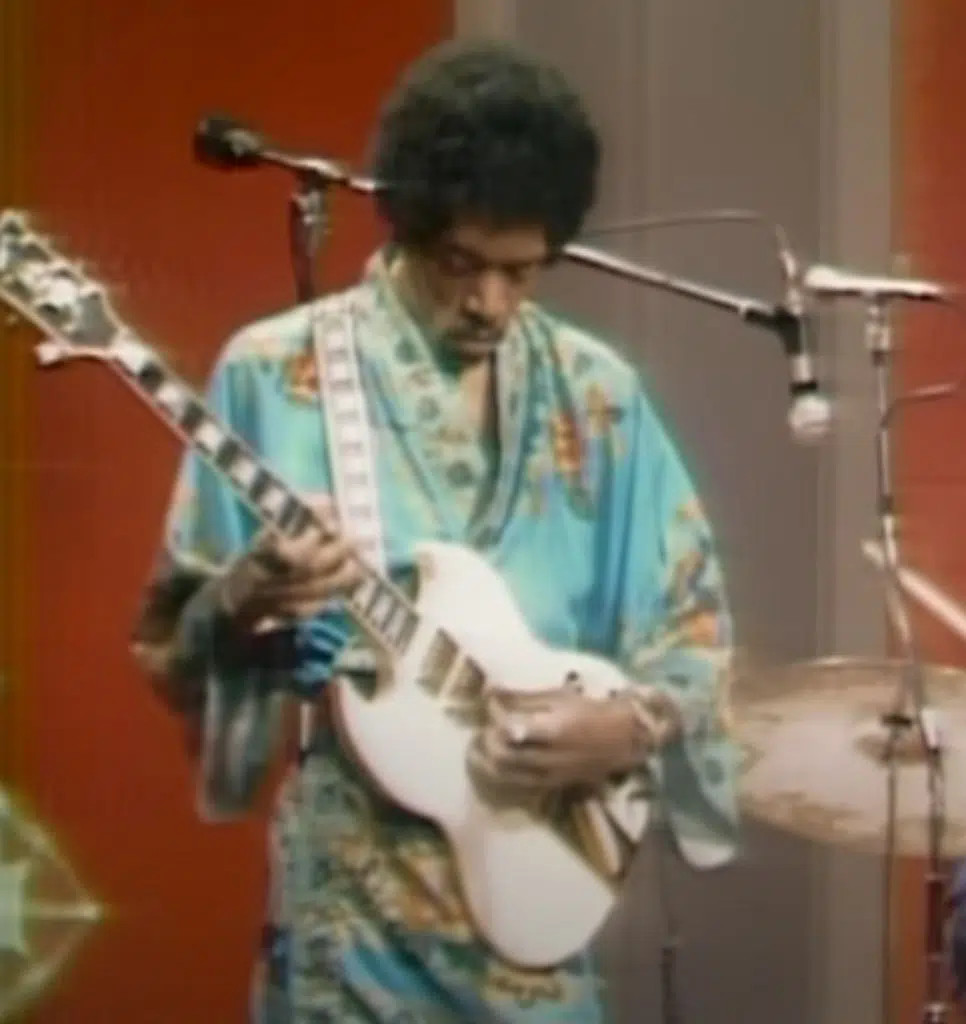 Jimi Hendrix playing his white Gibson SG Custom guitar on The Dick Cavett Show in 1969
Jimi Hendrix playing his white Gibson SG Custom guitar on The Dick Cavett Show in 1969
1970 Gibson Left-Handed Flying V: Custom Crafted Finale
This 1970 Gibson Flying V was custom-made for Jimi Hendrix in the spring of 1970. He played it in performances until his untimely death later that year, most notably at the Isle of Wight Festival in August 1970, one of his final major performances.
While largely based on the standard Flying V design, this custom instrument incorporated unique features tailored to Jimi Hendrix’s preferences. It featured split diamond inlays on the fretboard, full neck binding, a Les Paul Custom-style truss rod cover, and an inlaid Gibson logo on the headstock, adding touches of personalized elegance.
This 1970 Gibson Left-Handed Flying V is now preserved on display at the Hard Rock Cafe in London, England, serving as a poignant reminder of Jimi Hendrix’s final chapter and enduring legacy.
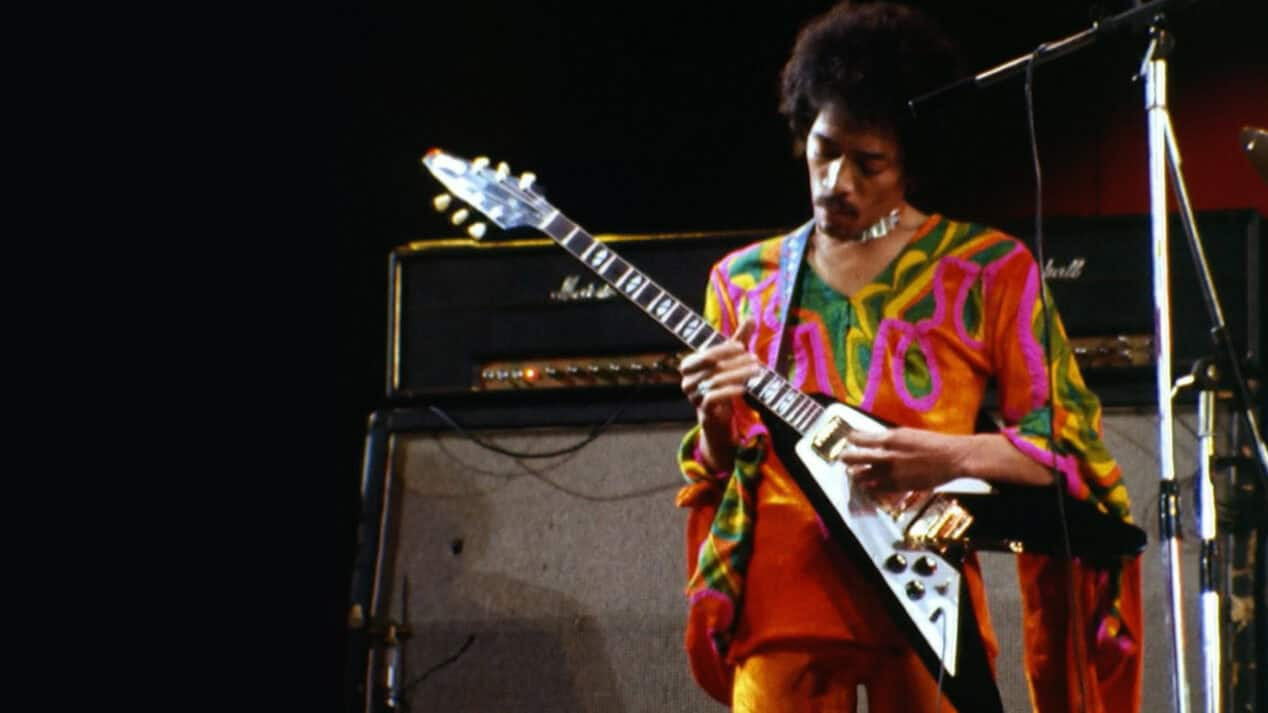 Jimi Hendrix playing his custom left-handed Gibson Flying V guitar at the Isle of Wight Festival in 1970
Jimi Hendrix playing his custom left-handed Gibson Flying V guitar at the Isle of Wight Festival in 1970
Jimi Hendrix’s Legend: Forged with Legendary Guitars
In his tragically short but immensely impactful career, Jimi Hendrix rapidly ascended to become the vanguard of rock guitar playing and an undisputed icon for guitarists across genres. The profound influence of his otherworldly playing style ensures that his choice of instruments will forever fascinate musicians and fans alike. While this fascination often leads aspiring players to pick up a Stratocaster, it’s important to remember that Jimi Hendrix, like many guitarists, was a true “guitar nerd” with an insatiable curiosity for exploring new sonic tools. So, whether you own any of the specific guitars of Jimi Hendrix detailed here or not, the spirit of his exploration and innovation is the real takeaway. Grab your own guitar, equip it with fresh Stringjoy strings, and let a Hendrix-inspired chord ring out! (And perhaps, heed the implicit advice: keep open flames a safe distance from your instrument.)


